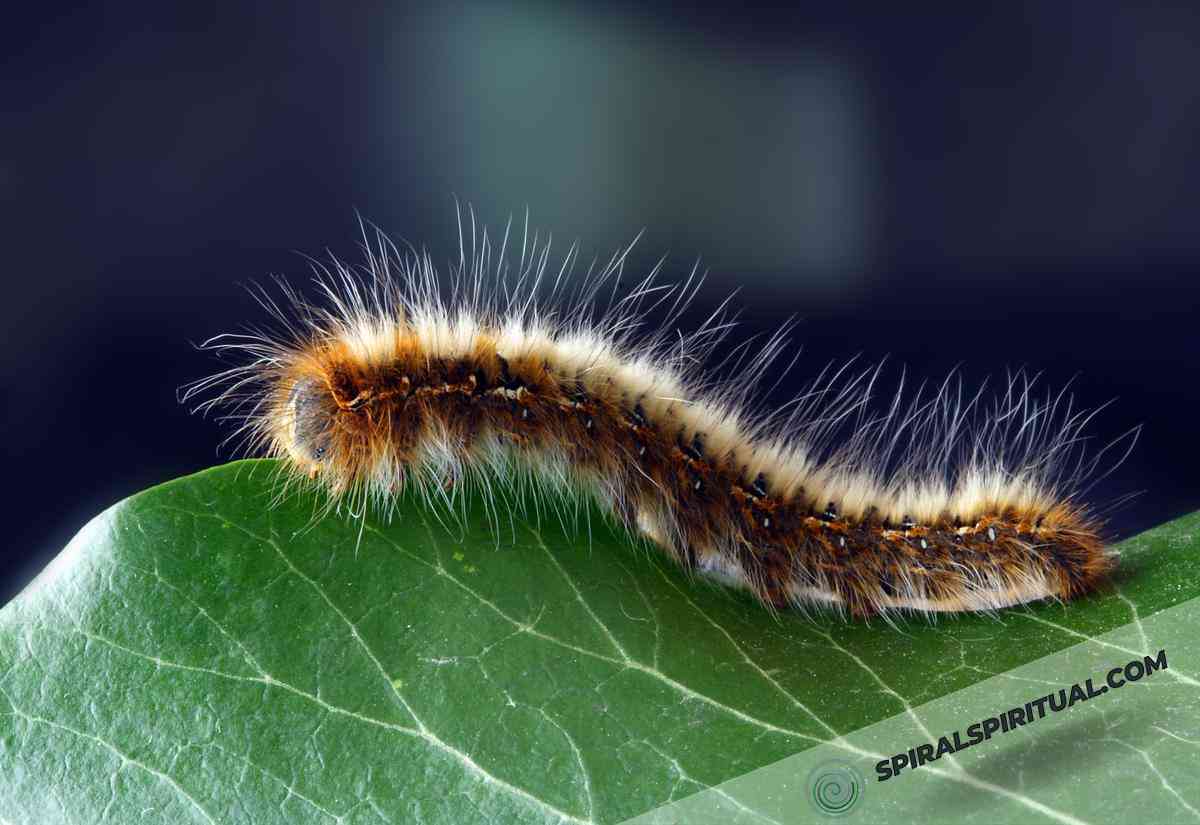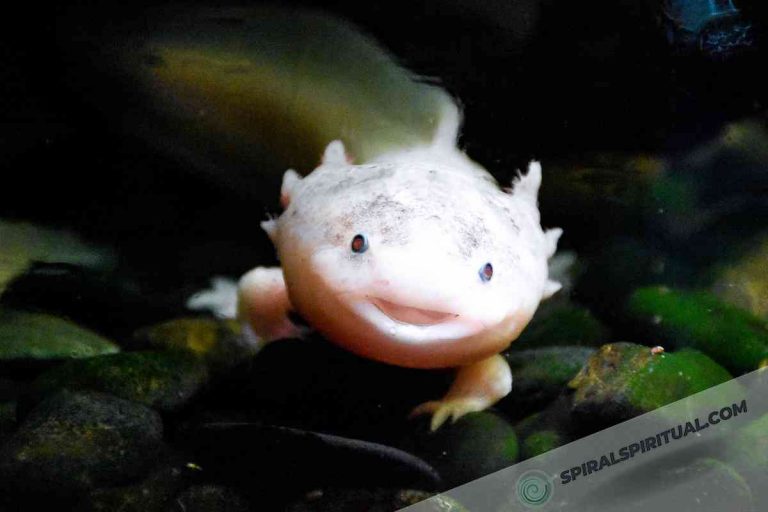Last Updated on February 2024
Caterpillars stand for change, growth, and potential in some spiritual views. They show a life stage where someone goes through big inner shifts and comes out transformed. This symbolism matches up with various faiths and ideas. These see the caterpillar’s power to turn into a butterfly or moth. To experts in spiritual meaning, caterpillars remind us life is cyclical. And to grow spiritually, we need to accept change.
5 Spiritual Meanings Behind the Caterpillar
One summer day, my friend Sarah found a tiny caterpillar in her backyard. Interested, she decided to bring it home and make a comfortable habitat for it. Over the next few weeks, as Sarah took care of and watched the caterpillar turn into a colorful butterfly, she realized the deep meaning it held. For her, the caterpillar represented personal growth, strength, and the beauty that comes from accepting change. Inspired by this, she began her own journey of self-discovery and change.
Here are five general spiritual meanings associated with caterpillars:
- Transformation: Caterpillars represent the ability of change and growth to transform things. Just as caterpillars go through a metamorphosis from larva to butterfly or moth, they remind us of the potential for personal and spiritual change. This symbol emphasizes the importance of seeing change as a chance for self-discovery and spiritual awakening.
- Patience: Caterpillars show us the importance of patience and determination. Their slow and steady journey to change represents the need for patience in our own spiritual journeys. By their example, caterpillars remind us to trust the process, even when it takes time and perseverance, as spiritual growth often happens gradually.
- Resilience: Caterpillars go through amazing challenges while they change, like breaking out of their cocoons, switching from crawling to flying, and getting used to a completely new life. They represent strength, encouraging us to face and get over our own obstacles. Caterpillars remind us that we have the power inside us to get through life’s troubles and come out stronger.
- Rebirth: When a caterpillar turns into a butterfly or moth, it represents a type of rebirth or renewal. This spiritual symbol means letting go of old ways of thinking, beliefs, and limitations to have a fresh start. Just as the caterpillar comes out of its cocoon with lovely wings, we too can come out of hard times, ready to welcome a new chapter and reach our full potential.
- Connection to cycles: Caterpillars are deeply connected to the natural cycles of life and the seasons. As they go through their life cycle, they remind us of the inherent rhythms and cycles that govern our spiritual journeys. The caterpillar symbolizes the cyclic nature of existence, encouraging us to honor the ebb and flow of life, embrace transitions, and understand that every stage serves a purpose in our spiritual evolution.
The Symbolism of Caterpillar in Different Cultures
Caterpillars symbolize different things in different cultures. Their meaning comes from beliefs, myths and spiritual traditions.
In Native American tradition, caterpillars represent rebirth, personal growth and nature’s cycle. The way they turn into butterflies is a potent symbol of inner change and spiritual development.
In Chinese culture, caterpillars mean good luck and prosperity. They symbolize growth and success in life, including wealth, career and relationships. Folklore often shows them as positive omens of change and new beginnings.
In Japanese tales, caterpillars symbolize endurance and dedication. The well-known story of the silkworm shows how rewards come from hard work and commitment.
These examples demonstrate the range of spiritual and cultural significance caterpillars have had across the world’s myths, narratives and wisdom traditions.
Caterpillar Color

Caterpillars are linked to change and transformation because they turn into butterflies or moths. In many cultures and beliefs, the color of a caterpillar can have symbolic meaning.
- One common color associated with caterpillars is green. Green is often seen as a symbol of growth, renewal, and fertility. It represents the earth, nature, and the cycle of life. Green caterpillars are believed to bring luck, abundance, and positive growth in various aspects of life.
- Another color often associated with caterpillars is black. Black is commonly associated with mystery, the unknown, and depth in many spiritual beliefs. Black caterpillars may be seen as a symbol of hidden potential, transformational change, and the need to explore one’s inner self.
- Yellow is another color frequently associated with caterpillars. It is often linked to joy, optimism, and enlightenment. Yellow caterpillars may represent the journey towards personal enlightenment, self-discovery, and the pursuit of happiness.
- In some beliefs, brown caterpillars are associated with grounding, stability, and endurance. Brown is seen as a color of the earth and is often connected to practicality and hard work. Brown caterpillars may symbolize the need to stay grounded and focused during times of change and transformation.
- White caterpillars are often seen as symbols of purity, innocence, and spiritual guidance. White represents light and purity in many spiritual traditions and may suggest a period of spiritual awakening or divine presence.
- Blue caterpillars are sometimes associated with communication, self-expression, and clarity. Blue is connected to the throat chakra and is believed to enhance communication skills. Blue caterpillars may symbolize the need for clear and open communication during transformative phases in life.
| Color | Symbolism |
|---|---|
| Green | Symbol of growth, renewal, and fertility |
| Black | Symbol of hidden potential and transformational change |
| Yellow | Symbol of joy, optimism, and enlightenment |
| Brown | Symbol of grounding, stability, and endurance |
| White | Symbol of purity, innocence, and spiritual guidance |
| Blue | Symbol of communication, self-expression, and clarity |
Is the Caterpillar a Good Omen?
Some people keep caterpillars as pets because they think they bring good luck and blessings. By caring for one, they see its change into a butterfly as representing personal growth and positive change. Raising a caterpillar is thought to invite these energies into their life and connect them to nature’s cycles.
If They’re Appearing in Your Dreams
According to dream interpretation, seeing a caterpillar can symbolize transformation and growth. It often means a coming change or period of personal development. As author Louise L. Hay said, “The caterpillar is a symbol of potential.”
In dreams, the caterpillar may reflect the dreamer’s own chances to embrace change, adapt, and evolve in life.
But dream meanings can vary based on someone’s personal beliefs and feelings about caterpillars. So it’s important to consider that when interpreting the symbolism.
If You See a Dead Caterpillar

Dream interpreters say that seeing a dead caterpillar in your dream can have symbolic meaning. It often signifies an ending or missing the chance for growth. The dead caterpillar may represent refusing to change, stagnating, or being afraid to embrace new possibilities in your life.
In the End
In summary, caterpillars have spiritual meaning in many cultures. Their change into butterflies or moths is often seen as representing personal development. Their colors also symbolize various traits. Seeing one in dreams can mean transformation coming or opportunities being missed. So in myths, dreams, and beliefs – caterpillars are reminders of the ability for positive change within us, and in life’s journey.
References
Here is the literature that was used for writing this article:
- “Animal-Speak: The Spiritual & Magical Powers of Creatures Great and Small” by Ted Andrews, Llewellyn Publications, 1993.
- “The Language of Butterflies: How Thieves, Hoarders, Scientists, and Other Obsessives Unlocked the Secrets of the World’s Favorite Insect” by Wendy Williams, Simon & Schuster, 2020.
- “Animal Spirits: How Human Psychology Drives the Economy, and Why It Matters for Global Capitalism” by George A. Akerlof and Robert J. Shiller, Princeton University Press, 2009.








